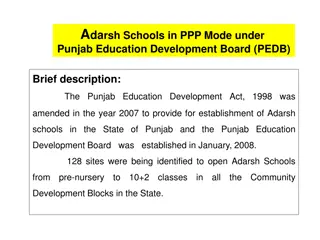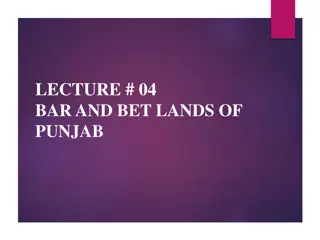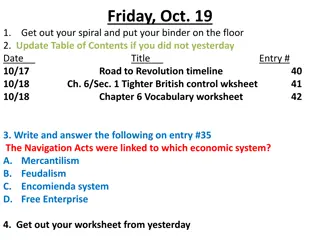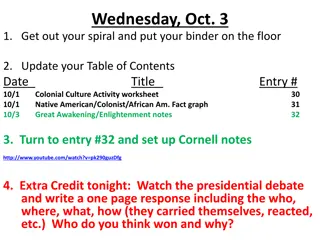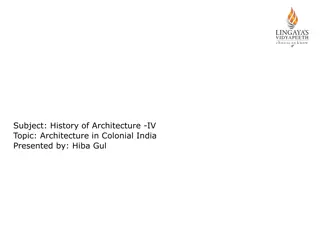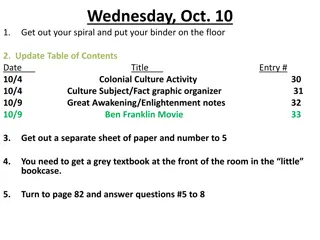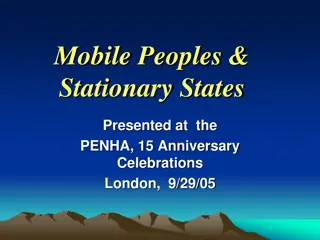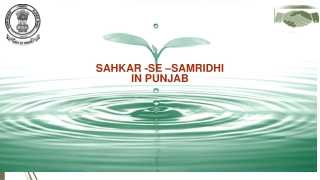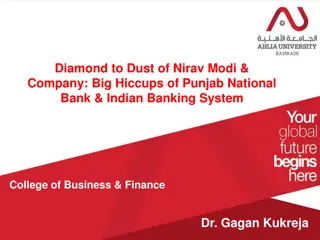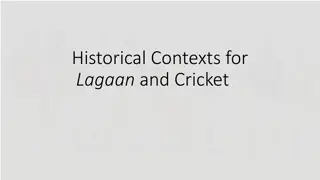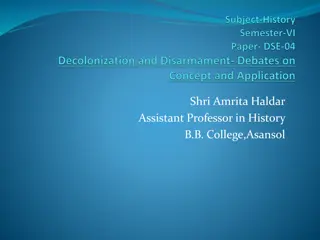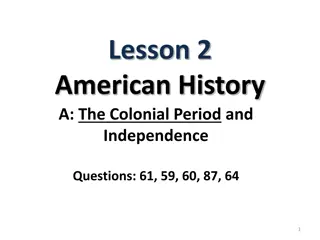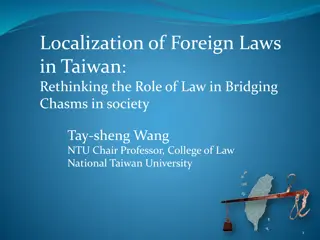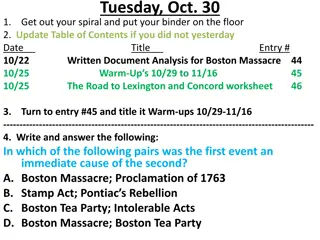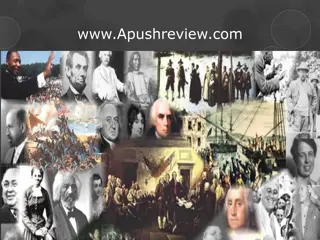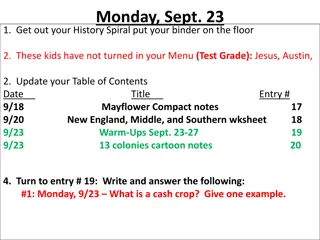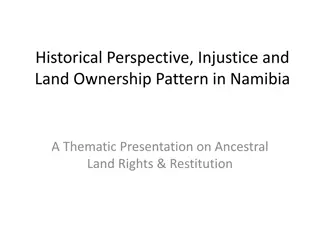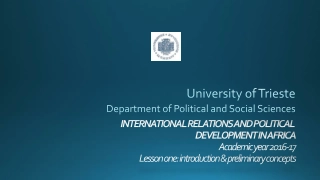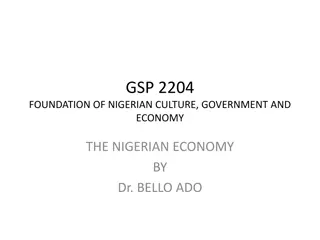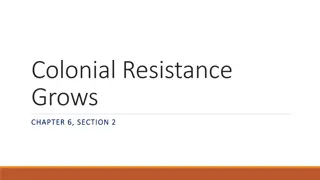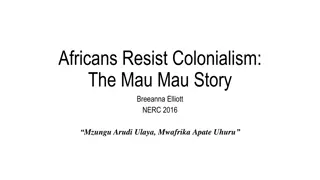The Udasis in Colonial Punjab: A Historical Overview
The article explores the significance of Udasis in Colonial Punjab, focusing on their survival amid sect excommunications, the influence of Baba Sri Chand Ji, and their beliefs related to Guru Nanak Dev Ji. It sheds light on the life of Baba Sri Chand Ji, his teachings, travels, and interactions with other Gurus, providing insights into this lesser-known aspect of Sikh history.
Download Presentation

Please find below an Image/Link to download the presentation.
The content on the website is provided AS IS for your information and personal use only. It may not be sold, licensed, or shared on other websites without obtaining consent from the author. Download presentation by click this link. If you encounter any issues during the download, it is possible that the publisher has removed the file from their server.
E N D
Presentation Transcript
Ground Rules 1. Punctual attendance 2. The whole book/article of the month must be read 3. Come with an open mind 4. Share your learning and listen to others 5. Keep the discussion relevant 6. Respect each others confidentiality
To remain single, have no fixed abode and own no property Other sects excommunicated - only Udasis survived Historical Background Gained prominence due to Masand corruption Nomination over succession Baba Sri Chand claimed to be natural heir to gurgaddi Guru Angad Dev Ji moved from Kartarpur to Khadur Sahib to avoid confrontation Udasi belief that Guru Nanak Dev Ji started two gaddis
Not much primary source material available Historical Background - Baba Sri Chand Ji Led most of life in seclusion - although sought out by various kings. Lived >100 years Many myths and fables Studied extensively Instructed to studys vedas/shastras/other Indian holy books Blessed by Guru Nanak Dev Ji with Naam Travelled extensively Mecca, Nepal, Tibet amongst others Composed Arta when Guru Nanak Dev Ji returned from 3rd Udasi Given Udasi dress by Guru Nanak Dev Ji following 4th Udasi Met with Guru Ram Das Ji, Guru Arjan Dev Ji and Guru Har Gobind Sahib Ji Reconciled to nomination of Guru Adopted Baba Gurditta Ji (who was married)
Let us sing the praises of Nanak, King of kings, Emperor of both worlds. The whole cosmos is His temple Congregations sing sweet songs in His praise. Millions of goddesses burn holy lamps in His honour Millions of gods sing psalms in His praise. Millions wash His lotus feet The moon and sun illuminate Him with their radiance. Masses of flowers are offering Him fragrance. The True Master, the True Light, He is merciful to the poor. The King of the Winds fans Him While saints and sages meditate on His holiness. He is universally accepted as the perfect Guru The entire cosmos vibrates with his celestial song. Bells ring out the tone -ONKAR- Continuously illluminating the heavens. He is one with God, Whose Name is Truth, In Nanak's Name saints find their support. Siri Chand, Nanak's son, declares, "Nanak is unattainable, unfathomable, unshakeable, and pure." Whoever sings Emperor Nanak's praises Resides in heaven and achieves complete salvation. Oh kind Master, protect those who seek your shelter Oh Nanak! You are the saviour; we are just your children.
Historical Background - Baba Gurditta Ji Recieved support and guidance from the Sikh Gurus Founded seats of culture and centres Four Duans (smouldering hearths) - active centres of missionary work Rediscovered places visited by previous Gurus Learning Gurmukhi mandatory Six Bakshishes (lit bounty) and Ten Sub-Bakshishes Missonary assignment conferred on an individual by the Guru Several famous individuals from Sikh history were Udasis Mihan Sahib, Bhai Pheru, Sutra Shah, Mahant Kirpal Looked after Anandpur Sahib and Hazur Sahib Thwarted attempted of Gurbaksh Das to take over Anandpur
Different words for establishment: Darbar, Gurudwara, Samadh, Udasi Establishments Dharamsala, Dera, Akhara 250 centres during Sikh rule Liberal state patronage - 500 rupees/year. Brahmbuta Akhara - 18,000 rupees/year. 200 resident sadhus/70 musicians Religious, educational and cultural activites Sansrikht/Gurmukhi schools, medical services, provided clothes/food, works on science, morals and maths taught Food and shelter 3 catergories - established by Udasi sadh, places assosiated with Sikh Gurus, centres connected with personalities assosiated with Guru Nanak Dev Ji. After Annexation - change in political, social and religious affairs of the state. Deprived Sikhs of their acquired power and prestige Utilized state machinery to turn socio-religious organisations into their mould - funding offered with terms and conditions Reduction in Udasi numbers and change in their organisational structure
Udasi Establishments Interesting comparision between Randhir Singh and Bramhanand views on the Udasi Samparda ? Udasis responsible for growth and development of towns/cities Lost several legal cases to the Akaalis Seperated from Sikhs in the Gurudwara Act 1925 Began to assert themselves as Hindus Many establishments lost in partition Replacement of traditional education system with the English system
State Partonage Grants frequently given by state Dharmarth - exempt from all obligations other than social responsibility Grantees expected to pray for state/enlist support for socio-political causes Enjoyed maximum revenue free grants in addition to Sodhis and Bedis 200 estalishments receiving 80,000 rupees/year Also obtained individual grants and prior to Sikh rule grants from Mughal state and Afghan chiefs Grants for reciting SGGS and preparing copies Partonage because of their popularity and this partonage increased their influence Cases of British continuing grants Mahant Custodians changed to Owners Many establishments turned to private houses closed to the public
Organisational Structure Spiritual affilitation to orginial duan/bakshish Akhara - largest organisation No fixed size Samadh Darbars/Gurudwaras Dharamsal Established in countryside Secular as well as religious purpose Every centre was independent and had a Mahant (organiser of religious, financial and admin affairs) Chela, Gurbhai, Sadh, Granthis, Cooks, Musicians Different modes of running centre Only Mahant could nominate succesor Wait till last breath thereby ensuring dedication If dispute - panchayat
Organisational Structure Own property; land, shops, houses, gardens and grooves Aims and Objections of sect Rules and regulations
Most information available from Udasi literature Majority written after 1920s Beliefs and Practises Great reverence for Guru Nanak and his followers Recite Japji Sahib, Rehras Sahib and Kirtan Sohila in addition to other bani Practice of keeping SGGS in establishments was common place Subscribe to principle of gnosis (insight into real nature) Author suggests this in conflict with Sikhi? Gyan-Ratnavali written by Udasi Object of Bhakti - supreme reality, necessity of Gyaan Udasis did not conform to a single pattern Believe in a seperate Gaddi from Guru Nanak Dev Ji to present Mahants Worship five deities? Believe in Vedas, Puranas, and the Shastras Initiation ceremony Avoid women/gold Name change, ending with Brahm/Das Dress/Naked
Beliefs and Practises Three types of Sadhu Several other denominations Worship of Idols Hatha-yoga Dhuni - continous smouldering fire Seva Complete surrender to God - detachment to the world akin to a lotus flower Gajo Ji Waheguru Avoid meat, etoh and smoking



